|
Panamax
Author: Reiner Stockhausen
Publisher: dlp games
Year: 2014
review by

| x |
|
|
|
|
|
|
|
|
|
|
|
|
|
|
|
|
|
|
|
|
|
|
|
|
|
|
|
|
|
|
|
|
|
|
|
|
|
|
|
|
|
|
|
|
|
|
|
|
|
|
|
|
|
|
|
|
|
|
|
|
|
|
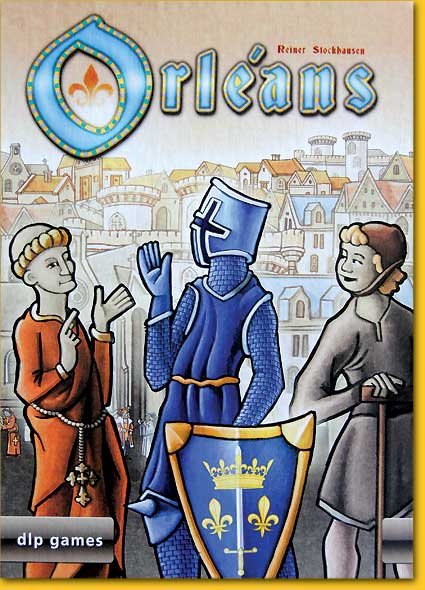 |
We can be brief about the theme, just like the rules are; they only spend two sentences on the issue. We are situated in medieval France, and we want to be best at absolutely everything. A most admirable pursuit! This will bring us money, goods and victory points, that’s how it went in those days. |
|
|
|
| x |
|
|
|
|
|
|
|
|
|
|
|
|
|
|
|
|
|
|
|
|
|
|
|
|
|
|
|
|
|
|
|
|
|
|
|
|
|
|
|
|
|
|
|
|
|
|
|
|
|
|
|
|
|
|
|
|
|
|
|
|
|
|
| Each player receives a player board, a bag, and four loyal followers in the appearance of a farmer, a boatman, a craftsman and a trader. Players can obtain many more of these four characters, and also of three additional characters knight, monk and scholar. At the beginning of each round the players draw character tokens from their bags, as many as allowed by their development (4 to 8). They subsequently place the tokens on their player boards. Ten different locations are depicted that can be activated by two or three specific character tiles. All players place their characters on their board simultaneously, but the locations are activated in turn order. On his turn, a player chooses one ‘filled’ location he wants to activate. |
|
|
|
| x |
|
|
|
|
|
|
|
|
|
|
|
|
|
|
|
|
|
|
|
|
|
|
|
|
|
|
|
|
|
|
|
|
|
|
|
|
|
|
|
|
|
|
|
|
|
|
|
|
|
|
|
|
|
|
|
|
|
|
|
|
|
|
 |
| x |
|
|
|
|
|
|
|
|
|
|
|
|
|
|
|
|
|
|
|
|
|
|
|
|
|
|
|
|
|
|
|
|
|
|
|
|
|
|
|
|
|
|
|
|
|
|
|
|
|
|
|
|
|
|
|
|
|
|
|
|
|
|
|
For example, if he had placed a farmer, a boatman and a trader at the Castle, he may take one knight tile, and advance one step on the corresponding character track. The latter allows him to draw five character tiles from the bag from now on, instead of four. Finally, he returns the used boatman, farmer and trader, and his new knight, to his bag. The next player may activate one of his locations. This continues in turn order until all locations containing the required character tiles have been activated. Players are also allowed to place only some of the required tiles at a specific location; that location cannot be activated right away, but the characters remain there for a future turn.
|
|
|
|
| x |
|
|
|
|
|
|
|
|
|
|
|
|
|
|
|
|
|
|
|
|
|
|
|
|
|
|
|
|
|
|
|
|
|
|
|
|
|
|
|
|
|
|
|
|
|
|
|
|
|
|
|
|
|
|
|
|
|
|
|
|
|
|
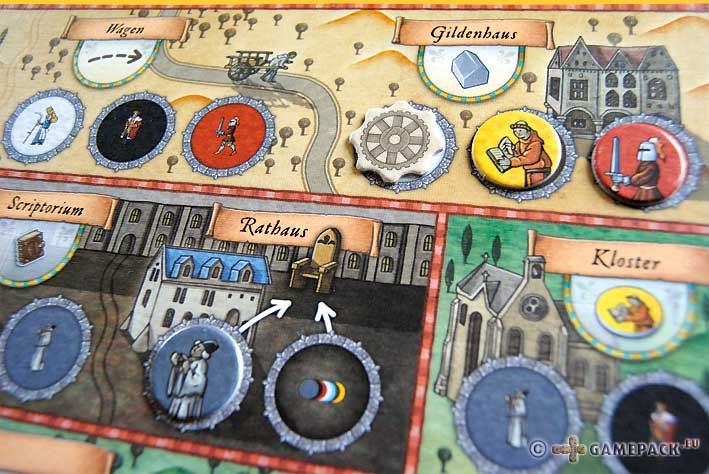 |
|
|
|
| x |
|
|
|
|
|
|
|
|
|
|
|
|
|
|
|
|
|
|
|
|
|
|
|
|
|
|
|
|
|
|
|
|
|
|
|
|
|
|
|
|
|
|
|
|
|
|
|
|
|
|
|
|
|
|
|
|
|
|
|
|
|
|
| Most of the locations on the player board allow the player to take a new character tile, in order to increase his number of followers, and to profit from the advantages of the corresponding character track. For example, when taking a new craftsman, a player also places a technology tile. This tile is placed at a location of his choice, and replaces a required character tile for the remainder of the game. This way it becomes easier to activate the location, since fewer character tiles are required. Also, it allows a player to give a certain direction to his development: if a player places technology tiles on all the locations that usually require farmers, he will hardly need any farmers during the game. Since there are no less than seven different characters it can be nice if there is at least one character that does not need your further attention. Monks are also very useful in this respect: they function as wild cards and can be used to replace any of the other characters. The character track of the trader is also very advantageous: the player may choose one place tile, which is basically a location that can be activated with character tiles. These additional locations often give interesting extra’s, or they can help you to get things done cheaper or faster. |
|
|
|
| x |
|
|
|
|
|
|
|
|
|
|
|
|
|
|
|
|
|
|
|
|
|
|
|
|
|
|
|
|
|
|
|
|
|
|
|
|
|
|
|
|
|
|
|
|
|
|
|
|
|
|
|
|
|
|
|
|
|
|
|
|
|
|
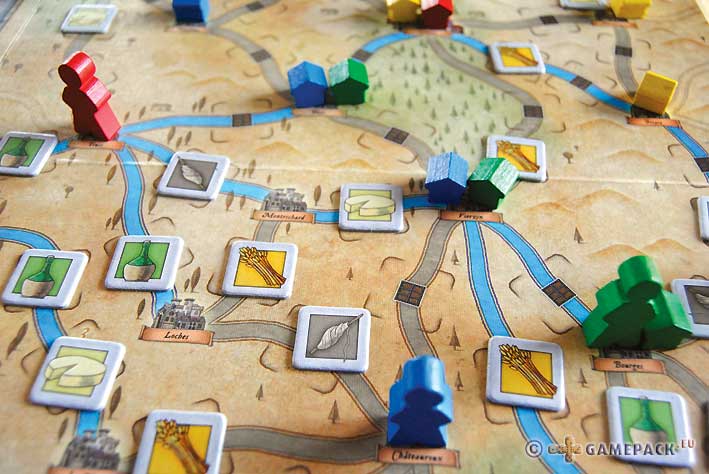 |
|
| x |
|
|
|
|
|
|
|
|
|
|
|
|
|
|
|
|
|
|
|
|
|
|
|
|
|
|
|
|
|
|
|
|
|
|
|
|
|
|
|
|
|
|
|
|
|
|
|
|
|
|
|
|
|
|
|
|
|
|
|
|
|
|
| In addition to locations that serve to obtain new character tiles there are three locations that are related to the merchant. The central board contains a map of France with cities connected by roads and rivers. Each player has one merchant figure that starts in Orléans. By activating the location ‘ship’ the salesman travels along a river to the next city, and by using the location ‘wagon’ he travels along a road. The roads and riverbanks are littered with valuable goods tiles which may be picked up along the way; they score victory points at the end of the game. The location ‘guildhall’ enables the player to build a guildhall in the city where his merchant is currently located. And this is where the other players enter the picture: each city may contain one guildhall only! Guildhalls also score points at the end of the game. |
|
|
|
| xx |
|
|
|
|
|
|
|
|
|
|
|
|
|
|
|
|
|
|
|
|
|
|
|
|
|
|
|
|
|
|
|
|
|
|
|
|
|
|
|
|
|
|
|
|
|
|
|
|
|
|
|
|
|
|
|
|
|
|
|
|
|
|
 |
|
| x |
|
|
|
|
|
|
|
|
|
|
|
|
|
|
|
|
|
|
|
|
|
|
|
|
|
|
|
|
|
|
|
|
|
|
|
|
|
|
|
|
|
|
|
|
|
|
|
|
|
|
|
|
|
|
|
|
|
|
|
|
|
|
Another location is the scriptorium, where players can advance on the development track at the bottom of the central board. When specific checkpoints on this track are reached, players receive money. The position on this track at the end of the game is also very important for the amount of victory points scored.
Finally there’s the town hall. A player may place one or two character tiles that he feels are superfluous. These characters are placed on the separate ‘beneficial deeds’ board. Depending on the specific beneficial deed, this earns the player some money or advancement on the development track. However, the character tiles remain there for the rest of the game! If a player fills the last position for one of the eight beneficial deeds, he receives the citizen-token, which scores points at the end of the game. |
|
|
|
| x |
|
|
|
|
|
|
|
|
|
|
|
|
|
|
|
|
|
|
|
|
|
|
|
|
|
|
|
|
|
|
|
|
|
|
|
|
|
|
|
|
|
|
|
|
|
|
|
|
|
|
|
|
|
|
|
|
|
|
|
|
|
|
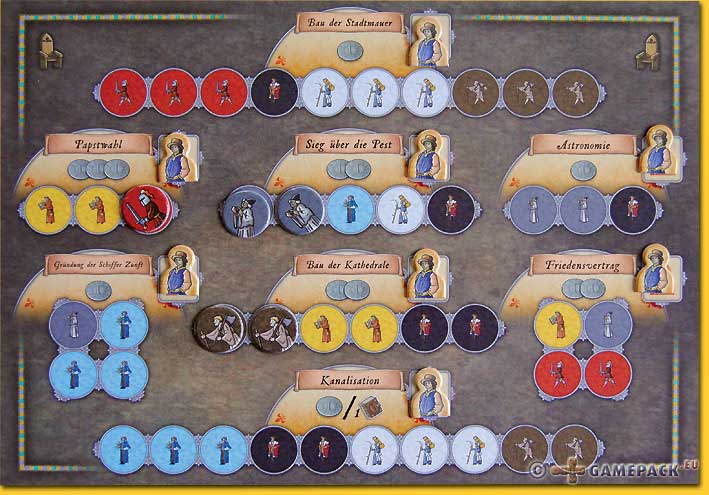 |
|
|
|
| x |
|
|
|
|
|
|
|
|
|
|
|
|
|
|
|
|
|
|
|
|
|
|
|
|
|
|
|
|
|
|
|
|
|
|
|
|
|
|
|
|
|
|
|
|
|
|
|
|
|
|
|
|
|
|
|
|
|
|
|
|
|
|
The game lasts 18 rounds. It’s easy to keep track of this, since each round begins with turning over a new event tile. Players take note of the event, and continue their play by drawing character tiles and carrying out actions. After the action phase, the event is carried out. This gives players time to prepare! The events can be nice: one coin per guildhall, or neutral: no new monks this round, or downright nasty: pay taxes over the collected goods tiles. The all-time depth is the – historically correct- occurrence of the Plague, something that happens no less than three times in the course of the game: all players draw a character tile from the bag that subsequently dies from the plague. Only the personal starting characters are immune. It is therefore wise to try to keep as many characters as possible, or at least the most important ones, on not-activated locations on the player board, and have only personal starting characters and useless surplus in the bag on that specific moment…
At the end of the game the points are scored. Coins are points (money has no other function in the game), and the goods tiles score 1-5 points. Then, the players add up their guildhalls and their citizen tiles, and multiply this total with their position (1-6) on the development track. These things added together is the grand total! |
|
|
|
| x |
|
|
|
|
|
|
|
|
|
|
|
|
|
|
|
|
|
|
|
|
|
|
|
|
|
|
|
|
|
|
|
|
|
|
|
|
|
|
|
|
|
|
|
|
|
|
|
|
|
|
|
|
|
|
|
|
|
|
|
|
|
|
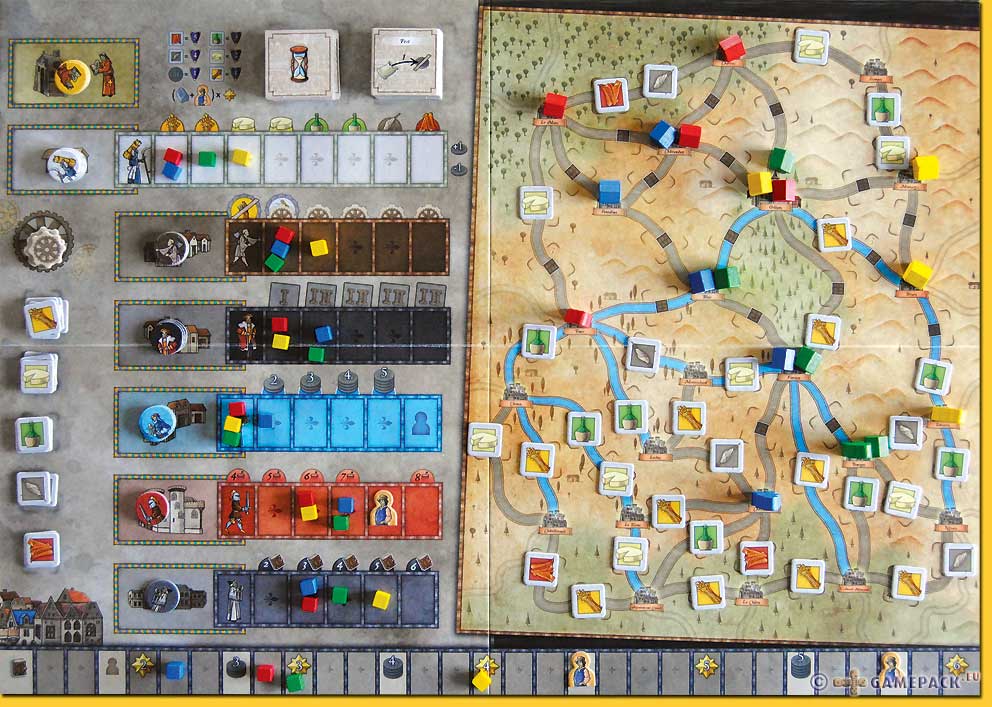 |
| x |
|
|
|
| x |
|
|
|
| x |
|
|
|
 |
|
|
|
|
|
|
|
|
|
|
|
|
|
|
|
|
|
|
|
|
|
|
|
|
|
|
|
|
|
|
|
|
|
|
|
|
|
|
|
|
|
|
|
|
|
|
|
|
|
|
|
|
|
| Orléans is solid as a rock. The basic principle of drawing tiles from the bag and using them to activate locations to improve your options is simple. The game obtains its depth from the intricate balance between the various components. For starters, the character tracks have been well-adjusted to the corresponding characters. In some cases the character tiles are almost indispensable (farmer, boatman), but the corresponding character track options are hardly interesting at all (goods, coins). The technology tiles (craftsman) and additional locations (trader) are already more interesting, but not indispensable. But the knight-character track allows players to draw up to 8 instead of the initial 4 character tiles per turn; this doubles your options per urn, and it is therefore unavoidable that every player will develop on this track. And also the scholar, whose character track allows players to advance on the development-track, which largely determines their final scores. |
|
|
|
| x |
|
|
|
|
|
|
|
|
|
|
|
|
|
|
|
|
|
|
|
|
|
|
|
|
|
|
|
|
|
|
|
|
|
|
|
|
|
|
|
|
|
|
|
|
|
|
|
|
|
|
|
|
|
|
|
|
|
|
|
|
|
|
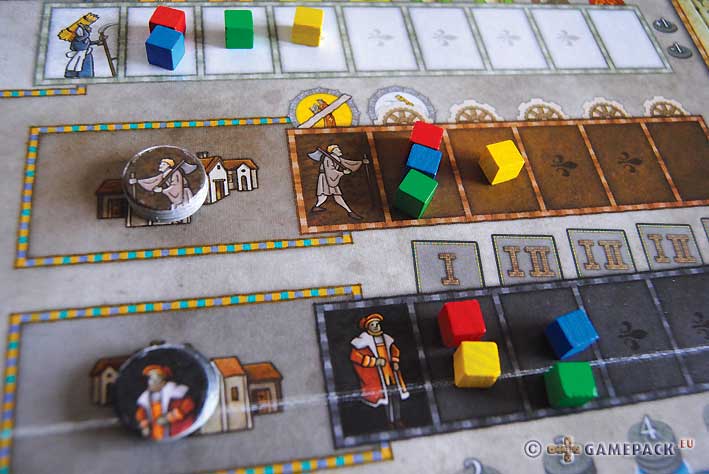 |
|
| x |
|
|
|
|
|
|
|
|
|
|
|
|
|
|
|
|
|
|
|
|
|
|
|
|
|
|
|
|
|
|
|
|
|
|
|
|
|
|
|
|
|
|
|
|
|
|
|
|
|
|
|
|
|
|
|
|
|
|
|
|
|
|
As a side-effect, players will have more knights and scholars than they actually need and want. Since this reduces the chance of drawing characters from the bag that players do want. And that’s where the Beneficial Deeds-board comes into play, where we can provide the unwanted knights and scholars with a useful occupation. And if we play it smart, we can earn some citizen tiles in the process!
The citizen tiles together with the guildhalls are equally important for the final score. So, if a player developed in such a way that he did not have surplus character tiles to send to the beneficial deeds board, he can instead spend his time and actions on traveling and building guildhalls. With the additional advantage that this will also earn him victory points in the shape of goods tiles.
|
|
|
|
| x |
|
|
|
|
|
|
|
|
|
|
|
|
|
|
|
|
|
|
|
|
|
|
|
|
|
|
|
|
|
|
|
|
|
|
|
|
|
|
|
|
|
|
|
|
|
|
|
|
|
|
|
|
|
|
|
|
|
|
|
|
|
|
 |
|
|
|
| x |
|
|
|
|
|
|
|
|
|
|
|
|
|
|
|
|
|
|
|
|
|
|
|
|
|
|
|
|
|
|
|
|
|
|
|
|
|
|
|
|
|
|
|
|
|
|
|
|
|
|
|
|
|
|
|
|
|
|
|
|
|
|
This way the players are not forced into a certain strategy by the game. There are many ways that potentially lead to victory; no winning strategy has revealed itself yet. Orléans seduces the players to play it over and over again and to try out different strategies. That all sounds very positive; are there no drawbacks at all to Orléans? Well, alright: after drawing the character tiles the players simultaneously start to work out their strategy: who goes where, what locations to activate? Especially later in the game, when they have more character tiles and the choices get difficult, it starts to become ‘multi-player Solitair’. It is advisable to play the game with players with the same ‘processing speed’, to prevent that the faster players have to sit idle whilst waiting for their slower opponents.
© 2015 Barbara van Vugt
Orléans, Reiner Stockhausen, dlp games, 2014 - 2 to 4 players, 10 years and up, 60 minutes
|
|
|
|
  |
|
|
|
|
|
|
|
|
|
|
|
|
|
|
|
|
|
|
|
|
|
|
|
|
|
|
|
|
|
|
|
|
|
|
|
|
|
|
|
|
|
|
|
|
|
|
|
|
|
|
|
|
|
  |
|
  |
|
|
|
|
|
|
|
|
|
|
|
|
|
|
|
|
|
|
|
|
|
  |
|
|
|
|
|
|
|
|
|
|
|
|
|
|
|
|
|
|
|
|
|
|
|
|
|
|
|
|
|
|
|
|
|
|
|
|
|
|
|
|
|
|
|
|
|
|
|
|
|
|
|
|
|
  |
|
|
|
|
|
|
|
|
|
|
|
|
|
|
|
|
|
|
|
|
|
|
|
|
|
|
|
|
|
|
|
|
|
|
|
|
|
|
|
|
|
|
|
|
|
|
|
|
|
|
|
|
|
| x |
|
|
|
|
|
|
|
|
|
|
|
|
|
|
|
|
|
|
|
|
|
|
|
|
|
|
|
|
|
|
|
|
|
|
|
|
|
|
|
|
|
|
|
|
|
|
|
|
|
|
|
|
|
|
|
|
|
|
|
|
|
|
| x |
|
|
|
|
|
|
|
|
|
|
|
|
|
|
|
|
|
|
|
|
|
|
|
|
|
|
|
|
|
|
|
|
|
|
|
|
|
|
|
|
|
|
|
|
|
|
|
|
|
|
|
|
|
|
|
|
|
|
|
|
|
|
 |
|
|
|
|
|
|
|
|
|
|
|
|
|
|
|
|
|
|
|
|
|
|
|
|
|
|
|
|
|
|
|
|
|
|
|
|
|
|
|
|
|
|
|
|
|
|
|
|
|
|
|
|
|
 |
|
|
|
|
|
|
|
|
|
|
|
|
|
|
|
|
|
|
|
|
|
|
|
|
|
|
|
|
|
|
|
|
|
|
|
|
|
|
|
|
|
|
|
|
|
|
|
|
|
|
|
|
|
| x |
|
|
|
|
|
|
|
|
|
|
|
|
|
|
|
|
|
|
|
|
|
|
|
|
|
|
|
|
|
|
|
|
|
|
|
|
|
|
|
|
|
|
|
|
|
|
|
|
|
|
|
|
|
|
|
|
|
|
|
|
|
|
 |
|
|
|
|
|
|
|
|
|
|
|
|
|
|
|
|
|
|
|
|
|
|
|
|
|
|
|
|
|
|
|
|
|
|
|
|
|
|
|
|
|
|
|
 |
|
|
|
|
|
|
|
|
|
|
|
|
|
|
|
|
|
|
|
|
|
|
|
|
|
|
|
|
|
|
|
|
|
|
|
|
|
|
|
|
|
|
|
|
|